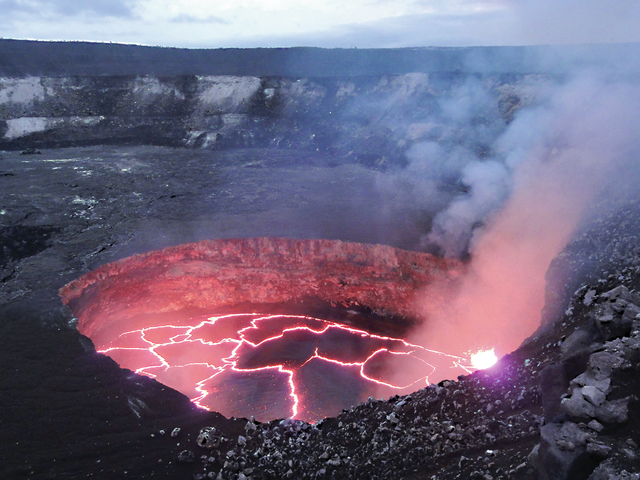Volcano Watch: Kilauea’s summit eruption in Halema‘uma‘u Crater turns 7

While Kilauea Volcano’s East Rift Zone eruption at Pu‘u ‘O‘o has been making headlines with the June 27 lava flow and its hazards, Kilauea’s summit eruption within Halema‘uma‘u Crater has steadily continued in the absence of much press.
ADVERTISING
However, the lack of media attention does not reflect on the eruption’s remarkable nature.
Kilauea’s ongoing summit eruption began March 19, 2008, after several months of increasing seismic tremor and gas emissions. A small “throat clearing” explosion opened a new crater (informally called the Overlook crater because it is located immediately below the former national park visitor overlook) on the wall of Halema‘uma‘u Crater.
During 2008-09, lava was only occasionally seen deep within this crater and often was masked by thick volcanic fume. In February 2010, however, lava rose within the Overlook crater and established a large lava lake that has persisted to today.
When the Overlook crater first opened, it was about 35 m (115 ft) wide, but today it is 170 m by 220 m (560 ft by 720 ft) in size. This enlargement is the result of frequent collapses of the crater walls, some of which have dropped rocks directly into the lava lake, triggering small explosions of lava spatter and gas.
Unlike the East Rift Zone eruption that sends lava flows out onto the slopes of Kilauea, the summit eruption emits primarily gas, along with a tiny amount of ash and fine particles (for example, Pele’s hair). To date, the lava within the summit vent has not flowed out of the Overlook crater. Instead, lava rises into the lake, releases gas and cools, and then sinks back into the magmatic system in a process called “magmatic convection.”
This containment within the crater lowers the risk posed by the lava itself, but the summit eruption creates a different kind of hazard that has a much farther reach than any lava flow.
The continuous gas emissions create volcanic air pollution, commonly called “vog,” that affects communities and agriculture in downwind areas, sometimes statewide. Vog is a respiratory irritant that can cause coughing, sore throats and headaches in otherwise healthy individuals, and can aggravate symptoms in people with pre-existing ailments, such as asthma and chronic obstructive pulmonary disease.
The agricultural industry, particularly in the Ka‘u District, has been hit hard by vog, which has damaged crops and corroded fences and other metal infrastructure.
Geologically, the Kilauea summit eruption stands out for the size of the lava lake it has created.
The lava lake in Halema‘uma‘u is most likely the second-largest lava lake on Earth, exceeded only by the lava lake in Nyiragongo Volcano in the Democratic Republic of the Congo. There are a few other — and much smaller — lava lakes on Earth, but the Halema‘uma‘u and Nyiragongo lava lakes are in a class of their own.
The expansive size of the lava lake in Halema‘uma‘u also translates to copious amounts of emitted heat. A recent study by University of Hawaii at Manoa researchers used satellite thermal images to calculate heat output from many of the Earth’s active volcanoes during the past 15 years, and Kilauea — counting the summit and East Rift Zone eruptions together — was at the top of the list. The researchers state that Kilauea’s top rank in heat output justifies its unofficial title as the most active volcano on Earth.
It’s not clear how long Kilauea’s summit eruption will last, but recent monitoring indicators show no signs of it slowing down — or speeding up.
Overall, the eruption has been characterized by a remarkable degree of steadiness.
Halema‘uma‘u Crater hosted a nearly continuous lava lake for at least 100 years (first written accounts are from the early 1800s) through the early 1900s, a testament to the potential for long-lasting eruptions at the summit of Kilauea.
Is it possible that Kilauea Volcano’s current summit eruption will persist for decades, as it did a century ago?
No one knows for sure, but if it does, we all will have to continue adapting to the effects of another long-term eruption.
Kilauea activity update
Kilauea’s East Rift Zone lava flow fed breakouts across the leading 3 km (2 mi) of the flow, but the leading tip of the flow remained stalled 500 m (550 yd) upslope from Highway 130. Breakouts also were active west of Kaohe Homesteads and on the north flank of Pu‘u ‘O‘o.
A new breakout began this past week near the forested cone of Kahauale‘a, about 2 km (1.2 mi) northeast of Pu‘u ‘O‘o.
The summit lava lake level tracked summit deformation, rising about 25 m (80 ft) during the past week with inflation. The lake level was 48 m (160 ft) below the rim of the Overlook crater as of Thursday.
One earthquake was reported felt on the Big Island this past week. At 12:22 a.m. March 6, a magnitude 3.7 earthquake occurred 5 km (3 mi) northeast of Kailua-Kona at a depth of 14 km (9 mi).
Visit the HVO website (http://hvo.wr.usgs.gov) for past Volcano Watch articles, Kilauea daily eruption updates, volcano status reports, current volcano photos, recent earthquakes and more; call (808) 967-8862 for a Kilauea summary update; email questions to askHVO@usgs.gov.
Volcano Watch (http://hvo.wr.usgs.gov/volcanowatch/) is a weekly article and activity update written by scientists at the U.S. Geological Survey’s Hawaiian Volcano Observatory.


